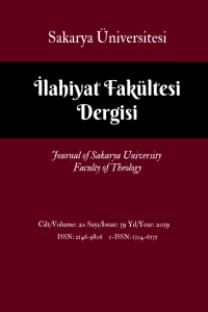HADİSİN TASHÎHİNDE SENED VE METNİN SIHHAT İLİŞKİSİNE İLLET VE ŞÂZ BAĞLAMINDA METODOLOJİK BİR YAKLAŞIM
Hadisin sıhhatinin belirlenmesinde, hadisin iki unsuru olan sened ve metnin sıhhat ilişkisine yönelik farklı yaklaşımlardan söz edilebilir. Bu yaklaşımlardan rivâyet ilimleri açısından en dikkat çekici olan, senedin sıhhatinin bir bütün olarak hadisin sıhhatini gerektirmeyeceğidir. Buna göre hadisin metninde olabilecek illet ve şâz gibi durumlar sened sahih olsa dahi hadisin sıhhatini zedelemektedir. Ancak hadis usûlünde yapılan sahih hadis tanımında zikredilen illetlerin daha çok hadislerin senedlerinde bulunması ve her şâz’ın sıhhati etkilememesi sıhhat tespitinde metnin esas alınmasını zorlaştırmaktadır. Dolayısıyla, bir hadis usûlü kâidesi olarak lanse edilen “sened sıhhati metnin sıhhatini gerektirmez” söyleminin hadis usûlü açısından ortaya çıkışı ve tarihi süreçteki gelişimi ve yansımaları önem arz etmektedir. Bu çalışmada hadis usûlü odaklı bir tespit ve analiz yapılarak, sahih hadisin kritiğinde sened ve metnin sıhhat bütünlüğü veya ayrılığı konusu illet ve şâz çerçevesinde tartışılacaktır.
The methodological Approach to Sanad and Text Authenticity Relationship in the Context of Hidden and Outlandish Content about Verification of Hadith
Defining the authenticity of hadith, it can be talked about different approaches directed towards the authenticity relationship between sanad and text which are two elements of the hadith. In terms of the narration sciences the most remarkable of these approaches is the authenticity of sanad that would not require the authenticity of the hadith as a whole. Accordingly, even if the sanad is authentic, situations such as defects and outlandish contents that can be located in the text of hadith, has damaged the authenticity of hadith. However, existing more defects in sanad’s and losting every outlandish content on authenticity mentioned in the definition of authentic hadith in hadith methodolgy has complicated basing on the text in the determination of authenticity. So the discourse “sanad’s authenticity is not required the text’s authenticity’’, shown as the rule of the hadith methodology and its emergence in terms of hadith methodology and its development and reflections in the historical process are important. In this study would be discussed the integrity or separation of authenticity of sanad and text in critical of authentic hadith by analyzing and determining together with focusing on hadith methodology in context of hidden and outlandish content.
Keywords:
hadith, sanad, text, verification, methodology, hidden or subtle defect, outlandish content ,
- ISSN: 2146-9806
- Yayın Aralığı: Yılda 2 Sayı
- Başlangıç: 2001
- Yayıncı: Sakarya Üniversitesi
Sayıdaki Diğer Makaleler
OSMANLI’DAN CUMHURİYET’E SÛFÎ GELENEĞİN TAŞIYICILARI
ULUSLARARASI HELAL ÜRÜN EKONOMİSİ SEMPOZYUMU (19‐21 Mart 2015, Sakarya Üniversitesi)
OSMANLIDA HUZUR DERSİ ÖRNEKLERİ TAHLİL ve TENKİTLİ TEFSİR METNİ NEŞİRLERİ II
FASİH ARAP DİLİNİN KAZANIMINDA ÖĞRETİMİN ÇOCUKLAR ve GENÇLER ÜZERİNDE ETKİSİ
